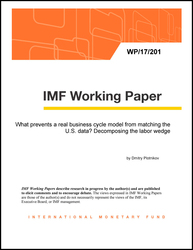
What Prevents a Real Business Cycle Model from Matching the U.S. Data? Decomposing the Labor Wedge
I carry out a business cycle accounting exercise (Chari, Kehoe and McGrattan, 2007) on the
U.S. data measured in wage units (Farmer (2010)) for the entire postwar period. In contrast to
a conventional approach, this approach preserves common medium-term business cycle
fluctuations in GDP, its components and the unemployment rate. Additionally, it facilitates
decomposition of the labor wedge into the labor supply and the labor demand wedges. Using
this business cycle accounting methodology, I find that in the transformed data, most
movements in GDP are accounted for by the labor supply wedge. Therefore, I reverse a key
finding of the real business cycle literature which asserts that 70% or more of economic
fluctuations can be explained by TFP shocks. In other words, the real business cycle model fits
the data badly because the assumption that households are on their labor supply equation is
flawed. This failure is masked by data that has been filtered with a conventional approach that
removes fluctuations at medium frequencies. My findings are consistent with the literature on
incomplete labor markets.
Publication date: September 2017
ISBN: 9781484318584
$18.00
Add to Cart by clicking price of the language and format you'd like to purchase
Available Languages and Formats
| English |
Prices in red indicate formats that are not yet available but are forthcoming.
Topics covered in this book
This title contains information about the following subjects.
Click on a subject if you would like to see other titles with the same subjects.
labor wedge , Forecasting and Simulation , Demand and Supply , Energy and the Macroeconomy
Summary
Copyright © 2010 - 2024
Powered by:
AIDC



